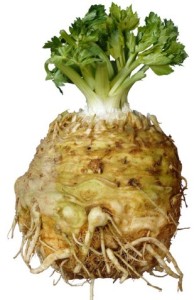 Celeriac, sometimes called celery root…is it the root of a celery stock? No, it has a similar taste, though it’s a root vegetable. It is very tasty in soups, salads and even as baked veggie fries! It looks like a lumpy turnip and smells like celery.
Celeriac, sometimes called celery root…is it the root of a celery stock? No, it has a similar taste, though it’s a root vegetable. It is very tasty in soups, salads and even as baked veggie fries! It looks like a lumpy turnip and smells like celery.
The aniseed notes of the celeriac give a punch to the iodized flavor of the mussels and other seafood. The vitamin C in celeriac helps the body absorb the iron found in large quantities, i.e., in seafood. Celeriac is also rich in sodium.
Celeriac contains a high water content and is low in calories. It is also rich in fiber, since it is composed essentially of cellulose and hemicellulose. These fibers not only ensure to regulate the absorption of nutrients, though also help regulate the bowels. They are particularly useful in dampening down hunger pangs.Celeriac is rich in potassium and contains water soluble vitamins, vitamin C and B vitamins. It is appetizing, diuretic, cleansing, anti-rheumatic and a real pick-me-up. The juice of celeriac is thought to help the healing process when applied directly on a compress.
They are available in winter and usually found with other roots like parsnips. Pick those with a hard bottom and smooth skin. To prepare celeriac, wash with water and cut off the top and bottom of the root and peel the rest with a knife. Slice and chop as needed. To keep white once cut, put in water with lemon juice or vinegar water. The root can be grated raw for salads. Slice or cube it for purees, soups, roasting and more!

